20
Oct
Combination of Pesticide Exposure, Limited Food Lead to Wild Bee Declines
 (Beyond Pesticides, October 20, 2020) The additive stress of pesticide exposure and food scarcity leads to significant declines in wild pollinator populations, according to research published by scientists at University of California, Davis. Although it is well known that insect and pollinators populations are at risk from multiple stressors related to industrial agriculture, comprehensive evaluations are a challenging scientific undertaking. “Just like humans, bees don’t face one single stress or threat,” said lead author Clara Stuligross, a PhD. candidate in ecology at UC Davis. “Understanding how multiple stressors interplay is really important, especially for bee populations in agricultural systems, where wild bees are commonly exposed to pesticides and food can be scarce.”
(Beyond Pesticides, October 20, 2020) The additive stress of pesticide exposure and food scarcity leads to significant declines in wild pollinator populations, according to research published by scientists at University of California, Davis. Although it is well known that insect and pollinators populations are at risk from multiple stressors related to industrial agriculture, comprehensive evaluations are a challenging scientific undertaking. “Just like humans, bees don’t face one single stress or threat,” said lead author Clara Stuligross, a PhD. candidate in ecology at UC Davis. “Understanding how multiple stressors interplay is really important, especially for bee populations in agricultural systems, where wild bees are commonly exposed to pesticides and food can be scarce.”
To better understand the interplay between these two stressors, researchers designed a field study. Mason bee pollinators were provided cages to nest in, and each stressor was separated out. One set of bees were provided high levels of food availability, while another received scant floral resources. Certain cages within each food level were treated with the product Admire Pro, a Bayer Cropscience insecticide containing the neonicotinoid imidacloprid.
Scientists found significant impacts on the factors that deal with mason bees’ reproductive success. This includes the likelihood that a female will nest, the number of offspring a female will produce, and the ratio of male to female offspring.
Taken alone, female mason bees exposed to Admire Pro (imidacloprid) were 10% less likely to nest, and when they did, produced 42% fewer offspring. Those with access to limited food supplies produced 26% fewer offspring than those with abundant resources. These stressors were additive, with pesticide exposure and limited floral resources combining to reduce reproduction by 57%, compared to the unexposed group.
The stressors also changed the sex of offspring that were successfully reared. Pesticide exposure led to a 33% reduction in daughters, and resource limitation caused a 48% decline. Synergism between these two stressors also acted additively. “In the bee world, males don’t matter so much,” said co-author Neal Williams, PhD, a pollination ecologist and professor in the Department of Entomology and Nematology at UC Davis. “Male numbers rarely limit population growth, but fewer females will reduce the reproductive potential of subsequent generations.”
The mechanisms that led to fewer offspring were multifaceted. Stressed mason bees slowed down the nest construction process (by 32% from the pesticide and 20% from limited food, which acted additively), and spent fewer days nesting (pesticide exposed bees started nesting 3 ½ days later than unexposed pollinators).
One critically important detail noted by scientists was that, even though all the mason bees subjected to pesticide-treated flowers displayed negative responses to exposure, only two of the eight pesticide-treated cages had flowers with detectable levels of imidacloprid. Although not imminently relevant to the present study, it highlights a particularly pernicious aspect of the pollinator crisis. The frequent inability entomologists and beekeepers have in tracing pesticide related bee-kills back to a source allows manufactures like Bayer to skirt responsibility, and spin science to blame beekeepers or factors other than pesticide exposure.
Despite the crisis fatigue that many in the United States and around the world are battling, the trouble with pollinator populations is not abating. A study published earlier this summer found that U.S. pollinator declines, particularly among native wild bees, limits crop yields. As the science shows, neonicotinoids are likely the most significant pesticide stressor for pollinators, and in a world where habitat loss and fragmentation show no sign of abating, America cannot afford to continue to subject it’s critically important wild insects to these combined threats.
The data reveal that it is simply not enough for well-intentioned advocates to plant pollinator habitat. Habitat in and of itself may assist, but it must be free of pesticides in order to truly protect wild pollinator populations. Find resources to help you plant pesticide-free pollinator habitat through the Bee Protective Habitat Guide and the Pollinator Friendly Seed and Nursery Directory. If you’re interested in advocating for real, meaningful, pollinator protection in your community, reach out to Beyond Pesticides at 202-543-5450 or [email protected] for the resources and information you need to convince your local lawmakers to act.
All unattributed positions and opinions in this piece are those of Beyond Pesticides.
Source: UC Davis press release, Proceedings of the Royal Society B










